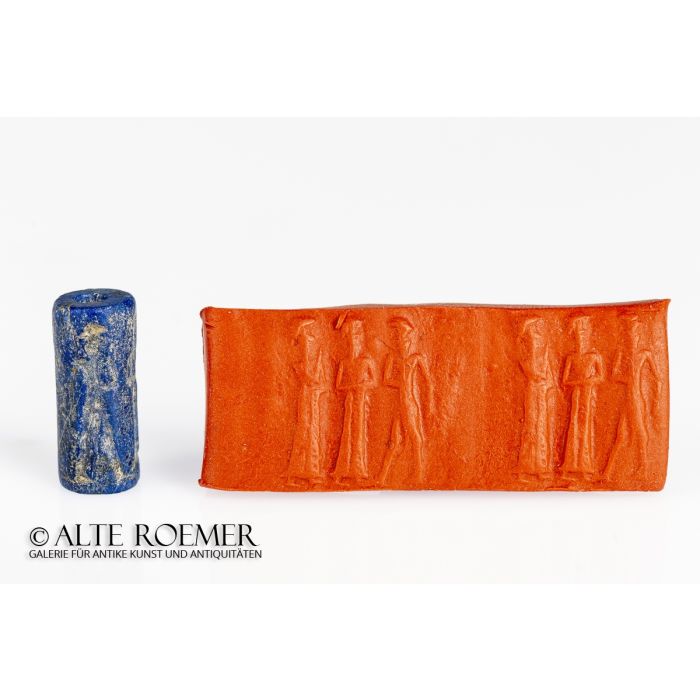Old Babylonian cylinder seal
Price: on request
Sold
Object number
AR2448-08
| Object: |
Mesopotamian cylinder seal
|
| Material: |
Blue stone, lapis lazuli. The use of the imported stone lapis lazuli is rare for this period. |
| Period: |
1900 BC to 1600 BC. Old Babylonian. |
| Description: |
Cylindrical seal with drill hole along the central axis. A worship scene is carved into the mantle of the seal. The seal impression shows three standing figures. On the right is a god with a mace. Next to him on the left is a worshipper facing him. And on the far left is a figure raising one hand.
|
| Background: |
Cylinder seals have been invented by the early civilizations of Mesopotamia. From the 4th Millenium BC onwards they conquered the whole Near East and beyond.
The emergence of this type of seal coincides with the first abundant use of scripture to manage the young highly organized city states. Such early seals are therefore a glimpse at the beginnings of civilization in Mesopotamia. Later seals broaden the view to all areas of administration, but also to trade and even personal matters. Many officials, traders and private persons must have possessed cylinder seals during the Bronze Age of Mesopotamia. What a happy instance for today's historians. Cylinder seals were made of durable materials and survived the millenia nearly unchanged. A treasury of images and inscriptions is reaching out to us from the Bronze Age. Thanks to the diverse original owners many stray finds have been made in the Near and Middle East. After the interest in antiquity has been reborn in Europe such finds have been preserved and valued. Many pieces could be attended to in private and public collections. And because of academic excavations with documented find contexts a chronology could be worked out. Today, also the stray pieces on the art market and in collections can be dated by iconographic means. For us it is a very special sensation to hold such seals in our hands and reflect the rise and fall of civilizations. |
| Dimensions: |
19mm length, 8mm diameter.
|
| Preservation: |
Almost perfect condition. Surface slightly worn with small chips at the ends. Including seal impression.
|
| Provenance: |
Acquired 2018 on the British art market. Previously in an important London private collection containing several hundred ancient seals. The piece was acquired for the collection between 1970 and 1988, collection no. PL8.
While in the London collection the cylinder seal was inspected and described by Professor Lambert. A copy of his notes is available. Wilfred George Lambert (1926 to 2011), a British archeologist specialized on Western Asia, was a professor at the University of Birmingham. After his retirement he was active in the ancient near eastern department of the British Museum. |
| Authenticity: |
We guarantee the authenticity of this object and all works of ancient art sold by us for life.
|


